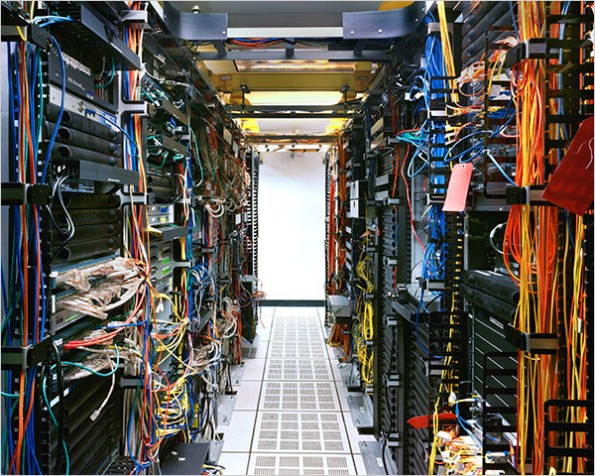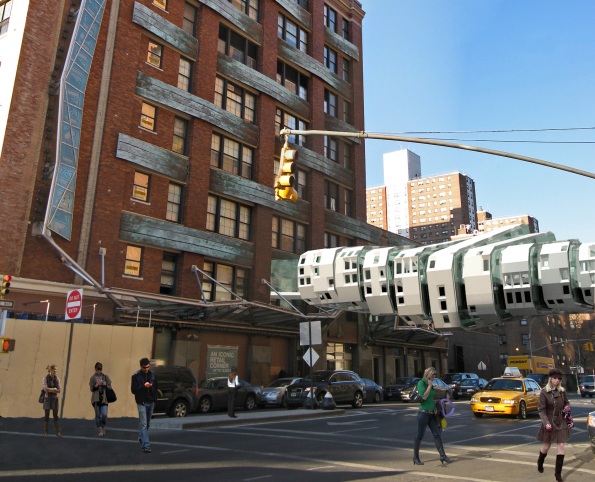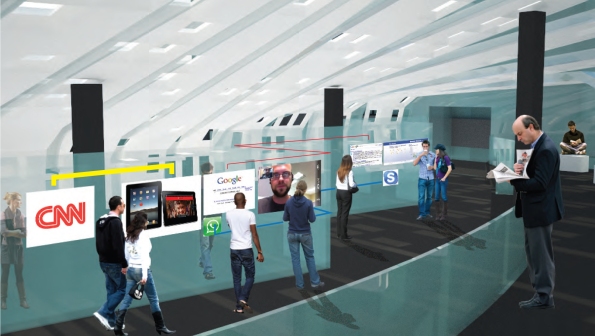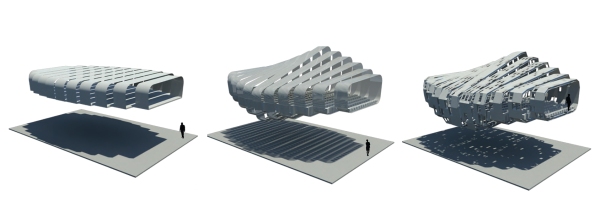Archive
Decaying Typologies: The New Library
Decaying Typologies is the title of my thesis research at Pratt Institute. It explores the idea of the library as one of many building types that are being eroded by the ubiquity of digital data. New forms of media and the ways in which we interact with them are becoming increasingly relevant to the realm of architecture. My research examines the co-evolving histories of library buildings and media types–particularly digitized books–and extrapolates current technological trends to determine the adjusted societal role that the library could potentially play in as little as ten years.
The Scene
Today it is clear that a diverse range of digital technologies are operating beyond what many of us long accepted as the traditional medium of computing—the desktop or laptop personal computer. Sensors are being embedded in our appliances, our phones, and even our running shoes. As pervasive as digital technology may be, however, there is still confusion and uncertainty about what the long-term implications will be for the built environment. What does any of this have to do with architecture? Digital technologies situate themselves at the boundary of our increasingly dematerialized world and the fundamentally material world of architecture and urbanism (‘Sentient City’ 8).
This thesis exploration investigates the design of a new type of library in the age of digitized books. With the decrease in printed book sales and the dramatic increase in electronic book sales, the space required to hold the library’s collection of printed books will no longer become necessary. The architectural significance is obvious. The spatial organization of the library through the 20th century had been based primarily on the size of the book collection. As books became more numerous, they could no longer be stored within the walls of the library’s reading room. Separate, larger spaces became necessary to accommodate growing amounts of information. By the 1990s, many libraries were essentially storing books wherever they could on any horizontal surface.
The inevitable conclusion is that book collections will outgrow even the largest of built structures. We have reached a critical mass of information that cannot be contained in traditional library buildings any longer. The proliferation of smart-phones, iPads, and other portable internet-connected electronic devices has allowed virtually any information to be accessed anywhere at anytime. The completion of the Google Books project would reduce the entire contents of any (and all) libraries in the world to a storehouse of digital information that anyone with a smart phone can access anywhere. Information access has become nearly ubiquitous, putting into question the fundamental purpose of the library building. Why would people go to a library if they can access information from wherever they happen to be at any time?
To address this issue, it helps to look at OMA’s Seattle Central Library through the lens of the individual versus the collective. One of the most prominent spaces in the Seattle Library is the Mixing Chamber, which OMA describes as a ‘trading floor’ for information. One-hundred-thirty-two computer work stations arranged in highly efficient rows certainly lend credence to this description; however, inspection of the computer station configuration reveals its highly individualized nature. Each user interacts with the screen in front of him and with information stored on a remote server without any regard for the other users in his immediate vicinity. Information exchange could potentially be more powerful if it involved both the limitless resources of distant server farms as well as the interests and browsing preferences of other users within close physical and social proximity. When considered from a localized perspective, the Seattle Library Mixing Chamber’s classification as a ‘trading floor’ for information seems to be a misnomer.
An alternate approach to information exchange is seen in the Toronto Public Library’s ‘Human Library’ project, which has strayed from the familiar notion of the library as a place full of books. Recognizing that a library is also full of patrons, information exchange is conducted in a more customary fashion—word of mouth, directly from person to person. The information being transferred cannot be found in any book—and that is its appeal. Finding published information is simply a matter of locating the right book; finding a personal story involves meaningful, satisfying conversations with people you may never have met before. Despite the apparently quaint premise of the Human Library, it has effectively resisted the ever-present threat of increasingly powerful electronics and internet applications. In fact, Toronto Public Library usage has been on the rise for years. Anne Marie Aikins, the Toronto Public Library’s manager of corporate communications, describes the allure of socializing the library:
“People will be in their own world with their computer screen, but they like to have people around them, so they’ll go into their branch. If you’re an online reader, you only have to come to the library once, to get a card and take out online books. But people keep coming back. In our feedback from the Human Library event, we found that a good portion of users heard about it from social media. In the least personal, most mediated way, they found a way to have a very personal experience.”
Indeed, information access and retrieval has the opportunity to be a much more enriching social experience. How can libraries become more socialized?
The Site
Rarely has any company in history been as successful as Google. There is little doubt that Google has transformed the Internet and become a key presence in our daily lives. Co-founders Larry Page and Sergey Brin started the company while they were still students at Stanford back in 1998. Although the company’s notoriety began by revolutionizing internet search, it has since used its unprecedented advertising revenue to branch off into countless other projects–web-based mail, free Internet video (Youtube), maps and street views, calendars, documents, language translation services among others. Perhaps most controversial is its Google Books project, initiated with very little fanfare in 2004. The quest to create a searchable digital database of the text within approximately 33 million printed books started out innocently enough, but when the project gained more momentum than anyone had anticipated, the courts interjected and people began to question: how will Google affect the library as we know it?
The site of the project is 111 8th Avenue, Google’s current New York City headquarters. Adjacent to the Chelsea Market and the High Line, this 2.9 million square-foot building occupies the entire city block between 15th and 16th streets and 8th and 9th avenues. Originally built as the NY/NJ Port Authority Commerce Building in 1932, it was redeveloped for telecommunications use in the late 1990s. Recently, it has been used as a carrier hotel, where multiple customers locate network, server, and storage gear and connect to a variety of network service providers. Situated along the Hudson Street/Ninth Avenue ‘fiber highway,’ it is considered to be among the world’s most wired buildings. The site is advantageous for Google in that it is one of the country’s most important physical connection points to the world’s telecommunications networks and the World Wide Web. This site has been chosen not only for its advantageous position as a global hub of internet connectivity, but also for its symbolic role as the birthplace of the digital books debate.
The Social Surface
Google’s ‘Trends’ and ‘Insights for Search’ engines allow a user to see the number of queries for any search word or term. Anyone can see how many times the word ‘architecture,’ for example, has been searched worldwide, over a variety of specified time frames (7 days, 30 days, 90 days, or several years). Simply knowing that a term has been searched before is not enough. Context is required. Who made the search and why?
The social surface is the physical manifestation of a network of information sharing. Beyond a simple computer terminal, it provides visual feedback when multiple users access Internet content from the same (or similar) websites, perform analogous Google searches, or retrieve comparable books, videos, songs, or any of the other media formats that the library must accommodate.
Two people matching a broad search term with many documented queries would not typically create a strong social connection; however, more obscure content that has been accessed much less frequently has the potential to produce a more substantial connection.
For example, two people who have never met walk into the new Google library, and both access the New York Times news website. A visual feedback interface built into the Social Surface alerts both users to the others’ presence. The continuity of the surface allows an uninterrupted line to be created literally connecting the screens of both users. Because the New York Times is one of the most widely accessed news sources in the world, the visual feedback provided to the users is relatively weak; however, the possibility still exists that a meaningful social connection can be made. Sure enough, both users access the ‘movies’ section of the site, and the visual feedback now becomes stronger. The strength of the social connection reaches an important threshold. Both users are now keenly aware of each other and could even engage in a game of cat-and-mouse. Which link will he click next? I wonder if he likes the same kind of movies I like?
Each user clicks the link to the same movie review—Inception written by A.O. Scott. The visual feedback built into the interface becomes even stronger. Perhaps even audio is triggered to emphasize the similarities of the searches. At this point, face-to-face interaction of the users becomes nearly unavoidable. The desire to see the other face that had accessed the same data at the same exact moment is too compelling to resist.
Another example shows how the surface can not only display latent existing social connections, but also encourage new interactions. Again, two strangers enter the future library. One searches for a book called In Defense of Food: An Eater’s Manifesto by Michael Pollan. The other searches for ‘healthy dinner ideas.’ Using an algorithm similar to the one Amazon uses to recommend items that other customers have purchased after viewing the same item you’re viewing, alternate web pages and search terms can be displayed alongside the user’s active display. The content of both users’ searches is quite similar (and therefore, yielding moderate interface feedback already), but the search suggestions can potentially lead to the same page—Food Rules: An Eater’s Manual by Michael Pollan, for example. Both users like to eat healthy, and perhaps, due to the unexpected connection created by the social surface, they can even eat dinner at the same table tonight!
The Architecture
Without the requirement of a space to house books, the new library program has essentially dissolved, making it more flexible and allowing it to recombine with other adjacent programs. In this case, the library is situated between the Google Headquarters at 111 8th Avenue (office program) and the Chelsea Market (retail, market, and restaurant program), which both . The only way for this spatial relationship to be achieved is to lift the building above the street, which also allows uninterrupted pedestrian and vehicular traffic below.
The most important design elements are the servers which are tied to the network within 111 8th avenue. The accommodation of servers requires several formal manipulations. First, since the continuous operation of servers is highly energy-intensive, the building that houses them must be able to provide some form of energy. The banded surfaces that constitute the building’s enclosure are thus fitted with photovoltaics and angled to increase their exposure to the southern sun. The rotation of the surfaces also creates a space that allows servers to be mounted directly beneath the floor slab. These servers will be used nearly 24 hours a day and will generate a great deal of heat. Rather than letting this heat escape as waste, it is absorbed into the floor slab directly above.
Each banded surface also has a series of operable apertures that can perform multiple functions. The apertures on the roof are controlled by the amount of sunlight that hits them. More direct sunlight will result in the apertures closing to collect the solar energy. Neighboring apertures will remain open. This not only produces energy, but decreases the amount of direct light and increases the amount of ambient light in the space. The apertures below the floor open and close relative to the temperature of the air. On cold days, the apertures remain closed so that the servers can be used to primarily heat the space above. On warm days, the apertures open so that the servers can be ventilated to prevent overheating. The openings in the wall surfaces are operated by users based on the way they occupy the space. For example, if a user is watching a video, the openings would close to prevent glare or other distracting light sources. If the user is reading or engaging in casual conversation, the apertures can be opened to provide more natural light.
The Architecture of the Cloud

The NJ2 Data Center in Weehawken, NJ ('Data Center Overload' Tom Vanderbilt for the New York Times, 2009)
My interest in information technology and its architectural implications began after reading an article by Tom Vanderbilt entitled Datatecture in the New York Times magazine of June 2009. The article talks about massive concentrations of servers called ‘data centers’ that form the hidden infrastructure behind all of our activity on the internet.
Despite the fact that data centers are essentially warehouses full of machines with no human presence, their architectural significance is both intriguing and indisputable. Part of the appeal lies in the secrecy of data center locations and specifications. Rich Miller, founder and editor of the web site Data Center Knowledge, compares the security concerns to the movie ‘Fight Club:’ “The first rule of data centers is: Don’t talk about data centers.” The hesitation to divulge any information about these facilities seems justified given the importance of the data being stored on the servers (aside from the trivial tweet or Facebook status update, of course) and the increasing competition brewing between web juggernauts Amazon, Google, Facebook, and Microsoft.
The data center is also a building typology that has been virtually disregarded in the architecture world. While surely an effective security measure, the nondescript facade of the typical data center is devoid of any discernible architectural features. Artistic expression appears to be the last priority when designing a building that is essentially a machine.
Worldwide demand for data centers is currently rising, and the pace is expected to accelerate as more people obtain access to the internet and the web itself continues to grow. As Mr. Vanderbilt points out, “the number of servers in the United States nearly quintupled from 1997 to 2007,” and approximately 10,000 servers are added to the pool every month. Furthermore, since 1999, the African continent (and its one billion residents) has increasingly become connected to the internet through a complex network of undersea cables. Large web companies are also seeking to reduce the distance between their servers and their users–a condition known as latency–and consequently, the time it takes users to access information. Adding 150-500 milliseconds to the time it takes to access search results may seem inconsequential to most, but a 100-millisecond delay allegedly costs Amazon 1% in sales revenue. The best way to solve this problem, of course, is to build more data centers. The explosion of data centers combined with their striking environmental consequences, presents a potential opportunity for architectural innovation.
Globally, data centers consume an estimated 1-2% of the world’s electricity, and the standard Google search produces 0.2 grams of carbon dioxide. This doesn’t sound like much, but extrapolating these carbon emissions over a billion search queries per day adds up quickly. ‘Google Instant,’ a service that provides updated search results after every character is typed into the search bar, requires much more energy and yields greater carbon emissions. Stated another way, a Google Instant search for the word ‘architecture’ generates 12 separate search queries (one for each letter) and therefore produces 12 times the CO2 emissions of a standard search.
Despite the fact that a standard Google search is, according to EPA estimates, 4,500 times more energy efficient than a drive to the library, inefficiencies abound in the design of data centers. The primary consideration is providing chilled air to cool the servers. Designers are approaching the problem from multiple angles–allocating hot and cold aisles among the rows of server racks, employing computational fluid dynamics to improve server layouts, and even opening the walls of the building to expose the servers to the naturally-cold air of northern climates. Yahoo has even utilized the colder climate of Lockport, New York for one of its recent chicken coop-inspired data centers.
The most fascinating development, however, is the dissolution of big-box data centers into widely distributed, densely-packed server capsules. Michael Manos, former general manager of data center operations at Microsoft, envisions the future of the data center as a series of these pre-equipped server farms that can be plugged in to an infrastructural node providing power, water, and network connectivity wherever they are needed. One could imagine a fleet of mobile data pods reorganizing themselves on an urban scale to maximize network speed and data capacity…



